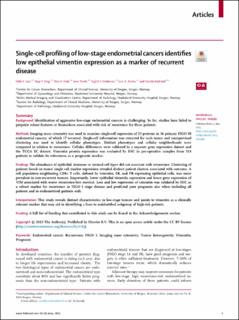Single-cell profiling of low-stage endometrial cancers identifies low epithelial vimentin expression as a marker of recurrent disease
Lien, Hilde Eide; Berg, Hege Fredriksen; Halle, Mari Kyllesø; Trovik, Jone; Haldorsen, Ingfrid S.; Akslen, Lars Andreas; Krakstad, Camilla
Journal article, Peer reviewed
Published version

Åpne
Permanent lenke
https://hdl.handle.net/11250/3096148Utgivelsesdato
2023Metadata
Vis full innførselSamlinger
- Department of Clinical Science [2318]
- Registrations from Cristin [9791]
Sammendrag
Background: Identification of aggressive low-stage endometrial cancers is challenging. So far, studies have failed to pinpoint robust features or biomarkers associated with risk of recurrence for these patients.
Methods: Imaging mass cytometry was used to examine single-cell expression of 23 proteins in 36 primary FIGO IB endometrial cancers, of which 17 recurred. Single-cell information was extracted for each tumor and unsupervised clustering was used to identify cellular phenotypes. Distinct phenotypes and cellular neighborhoods were compared in relation to recurrence. Cellular differences were validated in a separate gene expression dataset and the TCGA EC dataset. Vimentin protein expression was evaluated by IHC in pre-operative samples from 518 patients to validate its robustness as a prognostic marker.
Findings: The abundance of epithelial, immune or stromal cell types did not associate with recurrence. Clustering of patients based on tumor single cell marker expression revealed distinct patient clusters associated with outcome. A cell population neighboring CD8+ T cells, defined by vimentin, ER, and PR expressing epithelial cells, was more prevalent in non-recurrent tumors. Importantly, lower epithelial vimentin expression and lower gene expression of VIM associated with worse recurrence-free survival. Loss and low expression of vimentin was validated by IHC as a robust marker for recurrence in FIGO I stage disease and predicted poor prognosis also when including all patients and in endometrioid patients only.
Interpretation: This study reveals distinct characteristics in low-stage tumors and points to vimentin as a clinically relevant marker that may aid in identifying a here to unidentified subgroup of high-risk patients.
